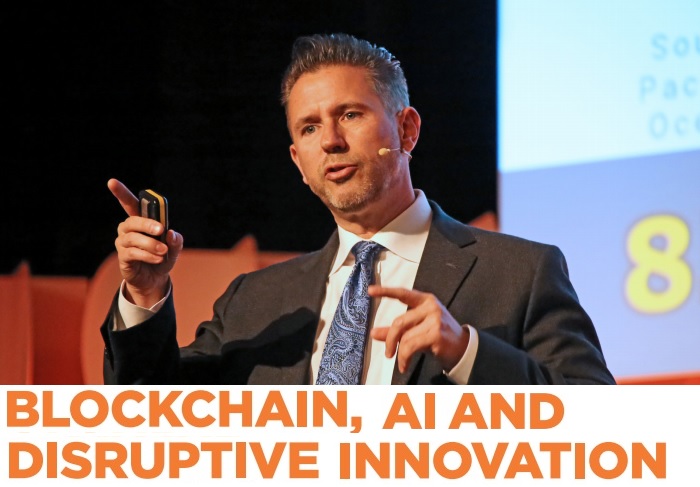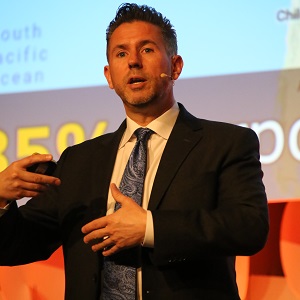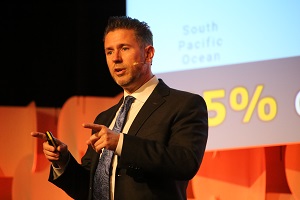The keynote speaker at the FIDI conference in Amsterdam was Patrick Schwerdtfeger. Patrick is an expert on technology trends. His brief was to talk about technology in general, and Blockchain in particular, to explore how it could change the way in which the moving industry works.

In his introduction, the FIDI President Freddy Paxton gave examples of how some businesses had disrupted markets: PayPal had disrupted the banking industry, e-mail had disrupted postal services. He said that the moving industry has a reputation for being conservative, with new technology often being met with reserve and mistrust and its complexity making people feel overwhelmed. “Yet some say Blockchain is opening a new era that will change the way we do business,” he said.
Patrick went one stage further in his own introduction. He said he was surprised at the camaraderie between competitors in the moving industry, that this was very rare and a huge opportunity as Blockchain relies on cooperation and is evolving as part of an ecosystem of technologies. This evolution was expanding exponentially. “It is not a linear progression,” he said. As an example, Patrick said that in 2000 it cost $17,000 to store 1Tb of data; today it costs $3. “The cost structure is collapsing. That’s what’s driving the whole thing.”
 In another example, Patrick illustrated how important the collection of data is and will become. Rolls Royce, he said, can monitor its Trent jet engines while in service, even using video cameras to identify potential faults while in flight. This data has allowed the company to offer airlines service contracts, much cheaper than they can do it themselves, yet returning very high margins to Rolls Royce representing 50% of the company’s profitability. They can do it because they have the data. “Guys, it’s all about data. How can you use data to provide a service to your clients that they don’t have today? It might become your most profitable revenue stream.”
In another example, Patrick illustrated how important the collection of data is and will become. Rolls Royce, he said, can monitor its Trent jet engines while in service, even using video cameras to identify potential faults while in flight. This data has allowed the company to offer airlines service contracts, much cheaper than they can do it themselves, yet returning very high margins to Rolls Royce representing 50% of the company’s profitability. They can do it because they have the data. “Guys, it’s all about data. How can you use data to provide a service to your clients that they don’t have today? It might become your most profitable revenue stream.”
Patrick explained that when the 5G network is running there will be an explosion of sensors as it will be cheap to do it. He said that companies are scared about technology growth wondering who is going to ‘eat their lunch’. “But we have to think, who else’s lunch can we eat? There is enormous opportunity for small, agile companies, to displace big heavyweights that are going to lose their advantage. This is a time to stay on the offensive. Either you are leveraging the technology, or the technology is leveraging you. As business leaders we have to run towards the technology.” Patrick encouraged the audience always to think how technology can be made to work for them in their businesses. The key is the data. “You need to ask what data do you have? What data could you get? How can you participate?”
Artificial Intelligence and machine learning
Patrick touched on artificial intelligence and machine learning. He used an example of how Tesla cars have the ability to learn to negotiate roads from each other. Once one car has learned a particularly tricky manoeuvre, they all know how to do it. It sounds a bit like The Borg in Star Trek, but it’s here. With systems that are linked to each other it should be possible for every system to learn from every other. “If you can set it up where everyone’s on a network and you can take the use cases of individual people and upload them to the cloud where the true intelligence resides, then everybody benefits from things that they never did. That’s why it’s so powerful. That’s why everyone is looking for the data. It’s the network effect that makes the growth exponential.”
 What is Blockchain
What is Blockchain
Patrick said that the concept of Blockchain is easier than you think. He said to think about an Excel spread sheet but, instead of being on one computer (a node), it’s on thousands of different computers simultaneously that all have the latest, most accurate version. That makes it almost impossible to hack because you can’t hack just one node because the others would immediately see it’s been tampered with. “You would have to successfully attack 51% of all the nodes in the same way at the same time for the hack to work,” said Patrick. “Every time a new block of transactions is added to the previous chain of blocks the newest block has a summary of the previous block embedded in it. So it can never be changed. Blockchain is the technology behind Bitcoin and, so far, it has never been hacked. “Believe me, everyone has tried,” he said. “Blockchain automates trust.”
Blockchain is a process of recording transactions that guarantees trust. There is no need to keep track of the transactions. The contracts execute themselves. Administration is reduced or eliminated. You don’t need to trust your partners. If you pay using a crypto currency, you can eliminate the banks completely.
Patrick said that Blockchain involves companies, their competitors, customers and suppliers; the moving industry is perfect for it. “It’s unusual to see an industry that’s so well suited for it,” he said, and encouraged the audience to work together to find ways in which Blockchain can be exploited.
Disruptive innovation
Patrick talked briefly about disruptive innovation. He said that disruptive innovation invalidates existing business markets. “You don’t see it coming and suddenly the entire industry is torn apart,” he said. He used various examples such as the way in which Apple disrupted the music business or how Uber now is disrupting food delivery.
He said that disruption usually comes from adjacent markets. “Look at your biggest supplier, who else do they sell to? Ask yourself, what do they do poorly? What’s not working? Can you do that yourself?”
Disruption tends to come from the sides which is why people get caught off guard. It also tends to cater to the least profitable market sector first. “Ask yourself, what do these people want? What are the new revenue opportunities? A lot of the time when you start something new you don’t have much competition because others don’t have the courage to try.”
In summing up, Patrick said that it’s not really about technology, it’s about leadership. “Who is going to be the first to try?”
Click here to see more from Patrick Schwerdtfeger.
Photos: Patrick Schwerdtfeger